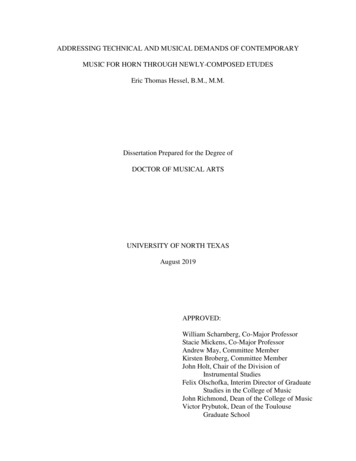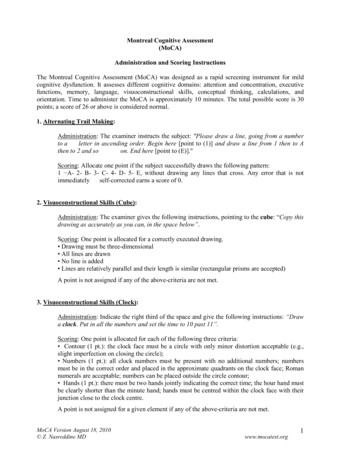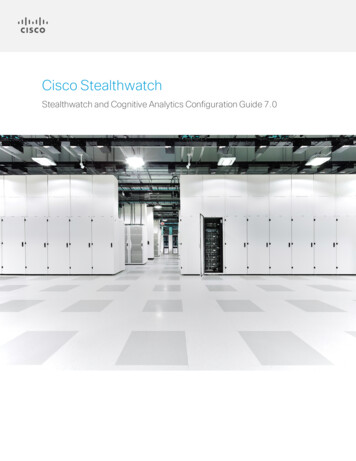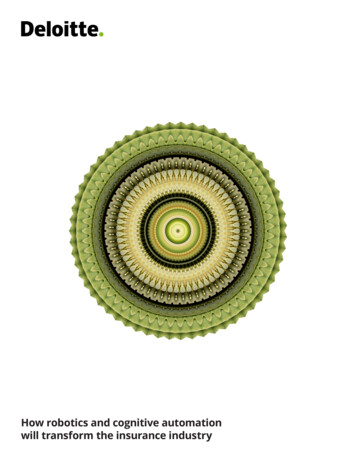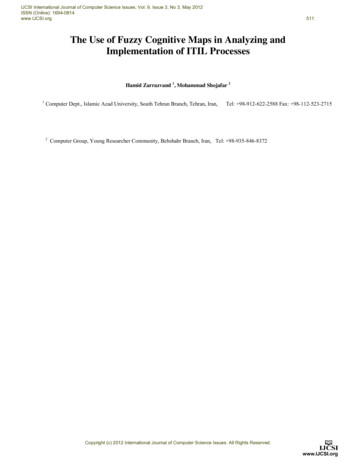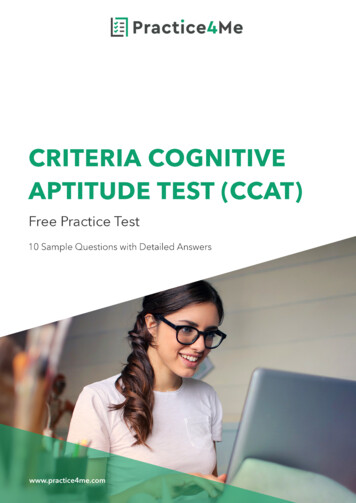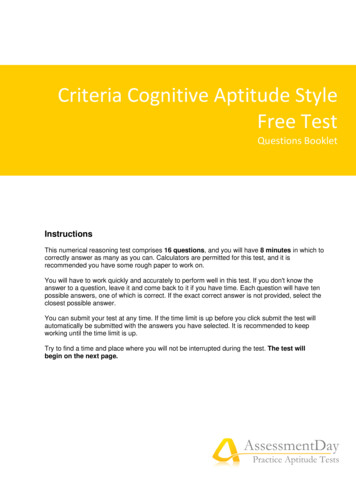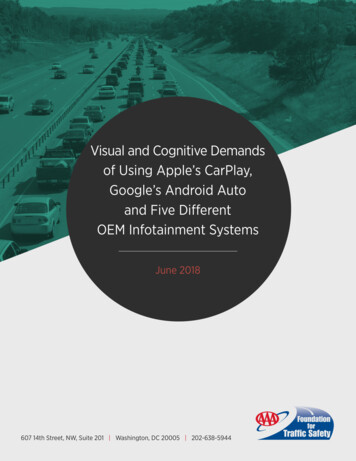
Transcription
Visual and Cognitive Demandsof Using Apple’s CarPlay,Google’s Android Autoand Five DifferentOEM Infotainment SystemsJune 2018607 14th Street, NW, Suite 201 Washington, DC 20005 202-638-5944
TitleVisual and Cognitive Demands of Using Apple’s CarPlay, Google’s Android Auto and FiveDifferent OEM Infotainment Systems(June 2018)AuthorsDavid L. Strayer, Joel M. Cooper, Madeleine M. McCarty, Douglas J. Getty, Camille L.Wheatley, Connor J. Motzkus, Kelly L. Mackenzie, Sydney M. Loveless, Jess Esplin, RachelM. Goethe, and Francesco BiondiUniversity of Utah 2018, AAA Foundation for Traffic Safetyi
ForewordThe expansion of new infotainment and In-Vehicle Information Systems (IVIS) into vehicles inrecent years has afforded drivers new activities and connectivity that can potentially impactsafety. It is important to understand how these new technologies impact drivers’ workload andperformance. Recent work sponsored by the AAA Foundation for Traffic Safety led to thedevelopment of new methods for measuring the visual and cognitive demands associated withdifferent in-vehicle systems.This report expands on earlier efforts from AAA Foundation for Traffic Safety, describing theresults of an on-road study looking at the visual and cognitive demand as well as the taskcompletion time for a variety of infotainment tasks and interaction methods. Importantly, thereport compares the performance of native OEM infotainment systems in five 2017 model yearvehicles with the performance of Apple CarPlay and Android Auto—two popular third-partysystems that can be paired with a vehicle’s interface. This report and its outcomes should be auseful reference for OEMs, developers of advanced IVIS, public agencies and researchers, aswell as the general driving population.C. Y. David Yang, Ph.D.Executive DirectorAAA Foundation for Traffic Safetyii
About the SponsorAAA Foundation for Traffic Safety607 14th Street, NW, Suite 201Washington, D.C. 20005202-638-5944www.aaafoundation.orgFounded in 1947, the AAA Foundation for Traffic Safety in Washington, D.C., is a not-forprofit, publicly supported charitable research and education organization dedicated tosaving lives by preventing traffic crashes and reducing injuries when crashes occur.Funding for this report was provided by voluntary contributions from AAA/CAA and theiraffiliated motor clubs, individual members, AAA-affiliated insurance companies, and otherorganizations or sources.This publication is distributed by the AAA Foundation for Traffic Safety at no charge, as apublic service. It may not be resold or used for commercial purposes without the explicitpermission of the foundation. It may, however, be copied in whole or in part and distributedfor free via any medium, provided the Foundation is given appropriate credit as the sourceof the material. The AAA Foundation for Traffic Safety assumes no liability for the use ormisuse of any information, opinions, findings, conclusions, or recommendations containedin this report.If trade or manufacturer’s names are mentioned, it is only because they are consideredessential to the object of this report and their mention should not be construed as anendorsement. The AAA Foundation for Traffic Safety does not endorse products ormanufacturers.iii
Table of ContentsList of Figures . . . vTerms and Definitions . . viiAbbreviated Terms . . . . ixExecutive Summary . . . . 1Introduction . . 2Method . . . . 5Results . . . 14Discussion . . . . 36References . . . . 40Appendix 1 . . . . . . 43Appendix 2 . . . . . . 57Appendix 3 . . . . . . 74iv
List of FiguresFigure 1. System: Cognitive Demand . . . 15Figure 2. System: Visual Demand . . 15Figure 3. System: Subjective Demand . . . 16Figure 4. System: Task Interaction Time . . . . 16Figure 5. System: Overall Demand . . . . . 17Figure 6. System by Mode of Interaction: Cognitive Demand . . . 17Figure 7. System by Mode of Interaction: Visual Demand . . . . 18Figure 8. System by Mode of Interaction: Subjective Demand . 18Figure 9. System by Mode of Interaction: Task Interaction Time . . . 19Figure 10. System by Mode of Interaction: Overall Demand . . . 19Figure 11. System by Task Type: Cognitive Demand . . . . . 20Figure 12. System by Task Type: Visual Demand . . . 20Figure 13. System by Task Type: Subjective Demand . . . . 21Figure 14. System by Task Type: Task Interaction Time . . . . . 21Figure 15. System by Task Type: Overall Demand . . 22Figure 16. System by Vehicle: Cognitive Demand . . . 22Figure 17. System by Vehicle: Visual Demand . . . . 23Figure 18. System by Vehicle: Subjective Demand . . . . 23Figure 19. System by Vehicle: Task Interaction Time . . . . 24Figure 20. System by Vehicle: Overall Demand . . . 24Figure 21. Vehicle by Mode of Interaction by System: Cognitive Demand . 25Figure 22. Vehicle by Mode of Interaction by System: Visual Demand . . 25Figure 23. Vehicle by Mode of Interaction by System: Subjective Demand . . 26Figure 24. Vehicle by Mode of Interaction by System: Task Interaction Time . . . 26Figure 25. Vehicle by Mode of Interaction by System: Overall Demand . . . 27Figure 26. Vehicle by Task Type by System: Cognitive Demand . 28Figure 27. Vehicle by Task Type by System: Visual Demand . . . 29Figure 28. Vehicle by Task Type by System: Subjective Demand . 30Figure 29. Vehicle by Task Type by System: Task Interaction Time . . . 31Figure 30. Vehicle by Task Type by System: Overall Demand . . . 32Figure 31. Task Type by Mode of Interaction by System: Cognitive Demand . . . 33v
Figure 32. Task Type by Mode of Interaction by System: Visual Demand . 33Figure 33. Task Type by Mode of Interaction by System: Subjective Demand . 34Figure 34. Task Type by Mode of Interaction by System: Task Interaction Time . . 34Figure 35. Task Type by Mode of Interaction by System: Overall Demand . . . 35vi
Terms and Definitions1Center stack – The center stack is located in the center of the dash to the right of the driver. AnLCD display is used to present textual and/or graphical information. Center stack systems ofteninclude a touch-screen interface to support visual/manual interactions so that drivers can select anoption and navigate menus by touch and/or use slider bars to scroll through options displayed onthe screen. With some vehicles, the selection of options may be made with manual buttonssurrounding the touch screen.Cohen’s d – An effect size estimate derived by a standardized difference between means. ACohen’s d value of 0.2 reflects a small effect size, a value of 0.4 reflects a medium effect size, anda value of 0.8 reflects a large effect size.Cognitive demand – The cognitive workload associated with the performance of a task. This wouldinclude perception, attention, memory and decision-making processes. In this report, we refer tothe cognitive demand associated with performing IVIS task types with different modes ofinteraction when the vehicle is in motion.Cognitive referent task – The N-back task (see below) served as the cognitive referent task in thecurrent research.Overall demand – Total visual, auditory, cognitive or physical resources required of the driver toaccomplish the primary driving task and interact with an in-vehicle infotainment system in a dualtask setting.Distraction potential – The potential distraction associated with secondary-task engagement. Thispotential may not be realized if drivers limit their secondary-task interactions to periods when thevehicle is not in motion.Driver distraction – The diversion of attention away from activities critical for safe driving towarda competing activity, which may result in insufficient or no attention to activities critical for safedriving (Regan, Hallett and Gordon, 2011).DRT – The Detection Response Task (DRT) is an International Standards Organization protocol(ISO 17488, 2015) for measuring attentional effects of cognitive load in driving. In this research,a vibrotactile device emitted a small vibration stimulus, similar to a vibrating cell phone, or anLED light stimulus changed color from orange to red. These changes cued the participant torespond as quickly as possible by pressing the microswitch attached to a finger against the steeringwheel. DRT reaction time increases and hit rate decreases as the workload of the driver increases.Dual task – Two tasks performed concurrently, typically the primary driving task plus a secondarytask.Evaluation – A procedure for assessing the effects of an interaction.In-vehicle information system (IVIS) – The collection of features and functions in vehicles thatallow motorists to complete tasks unrelated to driving while operating the vehicle. The IVIS1Some of these terms, definitions and abbreviations were taken directly from ISO (2012), Regan, Hallettand Gordon (2011), and NHTSA (2013).vii
features we tested involved up to four task types (audio entertainment, calling and dialing, textmessaging, and navigation).Method – High-level approach to an assessment, based on theory and principles, which implies anunderlying rationale in the choice of assessment techniques.Metric – Quantitative measure of driver behavior independent of the tool used to measure it.Linear mixed effects model – We compared the likelihood ratio of the full linear mixed effectsmodel to a partial linear mixed effects model without the effect (e.g., Task, Mode, Task by Mode,Vehicle) to determine if the effect in question accounted for a significant proportion of variance.NASA TLX – A questionnaire-based metric assessing the subjective workload of the driver. TheTLX assesses mental demand, physical demand, temporal demand, performance, effort andfrustration.N-back task – The N-back task presented a prerecorded, randomized set of numbers ranging fromzero to nine and presented in sequences of 10. In each sequence, numbers were spoken aloud at arate of one digit every 2.25 seconds. Participants were instructed to verbally repeat the numberthat was presented two trials earlier as they concurrently listened for the next number in thesequence. The N-back task places a high level of cognitive demand on the driver without imposingany visual/manual demands.Performance – The behavior demonstrated by a driver performing the driving task or a relatedtask.Primary driving tasks – Activities that the driver must undertake while driving, includingnavigating, path following, maneuvering and avoiding obstacles.Reference task – Type of task used for comparing different tests or test results across vehicles orsystems.Single task baseline – When the driver is performing the primary driving task (i.e., driving) withoutthe addition of workload imposed by IVIS interactions.Secondary task – A non-driving related additional task.Secondary task demand – The aggregate of cognitive, visual and manual demands required by anon-driving task.SuRT task – The variant of the Surrogate Reference Task (SuRT, ISO TS 14198; ISO, 2015) usedin this report differed from the ISO standard by requiring participants to use their finger to touchthe location of target items (larger circles) presented in a field of distractors (smaller circles) on aniPad Mini tablet computer that was mounted in a similar position in all the vehicles. The SuRTtask places a high level of visual/manual demand on the driver because they must look at and touchthe display to perform the task. The SuRT task served as a referent for the visual/manual demandsassociated with performing IVIS interactions.Task – The process of achieving a specific and measurable goal.Task interaction time – The time to complete a task. Task interaction time was defined as the timefrom the moment participants first initiated an action to the time when the last action in the taskhad terminated and the participant said, “Done”. Based on the project team’s interpretation of theNHTSA visual occlusion test, the maximum total task length should be less than 24 seconds.viii
Task types – Tasks were categorized into one of four task types: Audio entertainment, calling anddialing, text messaging and navigation, depending on vehicle capabilities. These task types werecompleted via different modalities equipped in each vehicle (i.e. touch screen, voice recognition)for each interaction.Visual demand – The visual workload associated with the performance of a task. This wouldinclude the structural interference associated with taking the eyes off the forward roadway as wellas the central interference in visual processing that arises from cognitive demand. In this report,we refer to the visual demand associated with performing IVIS tasks with different modes ofinteraction when the vehicle is in motion.Visual referent task – A variant of the SuRT task (see above) served as the visual referent task inthe current research.Workload – The aggregate of cognitive, visual and manual demands on the driver. A motorist’sworkload reflects a combination of demands from the primary task of driving and any secondarytasks performed by the driver. The terms “demand” and “workload” are used interchangeably int
607 14th Street, NW, Suite 201 Washington, DC 20005 202-638-5944. i Title. Visual and Cognitive Demands of Using Apple’s CarPlay, Google’s Android Auto and Five Different OEM Infotainment Systems (June 2018) Authors. David L. Strayer, Joel M. Cooper, Madeleine M. McCarty, Douglas J. Getty, Camille L. Wheatley, Connor J. Motzkus, Kelly L. Mackenzie, Sydney M. Loveless, Jess Esplin .Cited by: 3Publish Year: 2018Author: Jess Esplin, Sydney M. Loveless, Kelly L. Mackenzie, Connor J. Motzkus, Camille L. Wheatley
